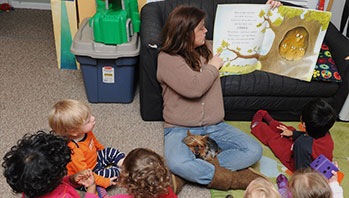- crayons or markers (optional)
- paper
- boat
- water
MA Standards:
Literature/RL.PK.MA.1: With prompting and support, ask and answer questions about a story or a poem read aloud.
Literature/RL.PK.MA.10: Listen actively as an individual and as a member of a group to a variety of age-appropriate literature read aloud.
Literature/RL.PK.MA.9: With prompting and support, make connections between a story or poem and one’s own experiences.
Head Start Outcomes:
Literacy Knowledge/Book Appreciation and Knowledge: Asks and answers questions and makes comments about print materials.
PreK Learning Guidelines:
English Language Arts/Reading and Literature 6: Listen to a wide variety of age appropriate literature read aloud.
English Language Arts/Reading and Literature 10: Engage actively in read-aloud activities by asking questions, offering ideas, predicting or retelling important parts of a story or informational book.
Read Together: Toy Boat #2

© Commonwealth of Massachusetts, Department of Early Education and Care (Jennifer Waddell photographer). All rights reserved.
STEM Key Concepts: Water has currents
ELA Focus Skills: Listening and Speaking, Compare and Contrast, Make Connections, Story Comprehension (Character), Recall and Retell, Vocabulary
Before You Read
Show children the book cover and ask them to locate and read the title. Ask, Who remembers this book? Who are the characters in the book? Remind children that a character is a person or thing that does the action in a story.
As You Read
Read with expression. Hold the book so everyone can see the pages as you read. Help children visualize the action of the story. For example,
- Encourage children to say “Move along!” with the other boats and “I am moving along!” with the toy boat.
- Pause when the speedboat rushes by. Read the words slowly. Ask, Can you imagine the waves pushing and splashing?
- Pause on the pages that feature the little fishing boat. Ask children, How does the fishing boat help the toy boat? (the fishing boat circles the little toy boat, which causes the toy boat to turn and catch a breeze in its sail).
After You Read
Talk about the book with children. Ask questions such as,
- Do you think this is a true story or a made-up story? Why? (the boats talk)
- How is this story like the story Row, Row, Your Boat? How is it different? Encourage children to mention how the water behaves in both stories.
